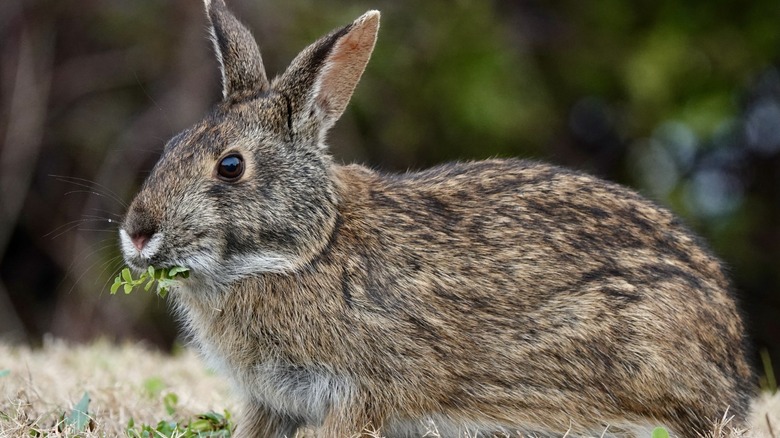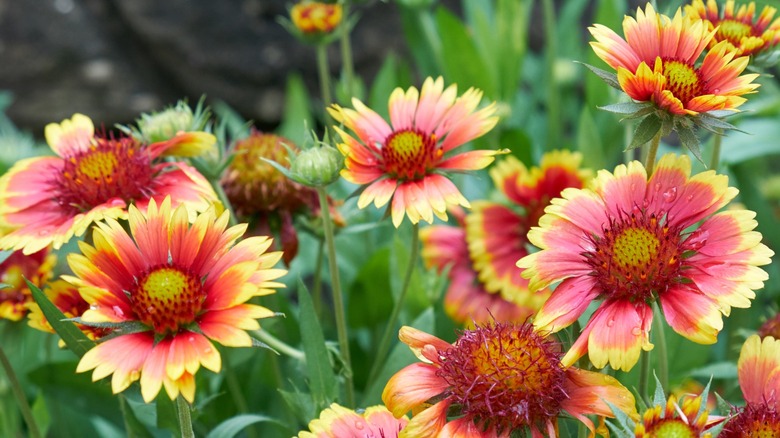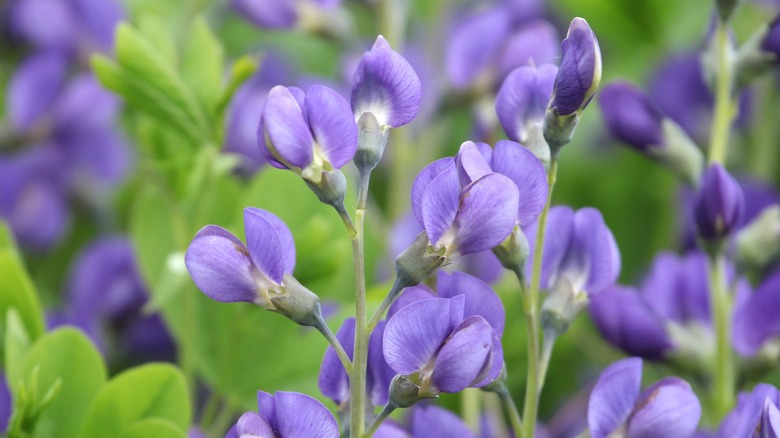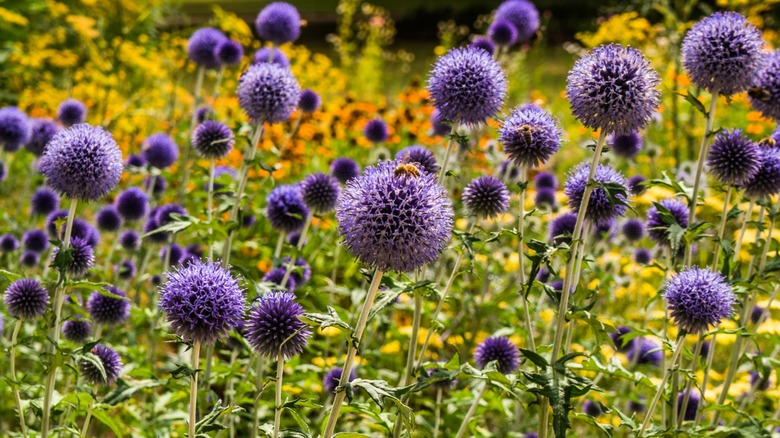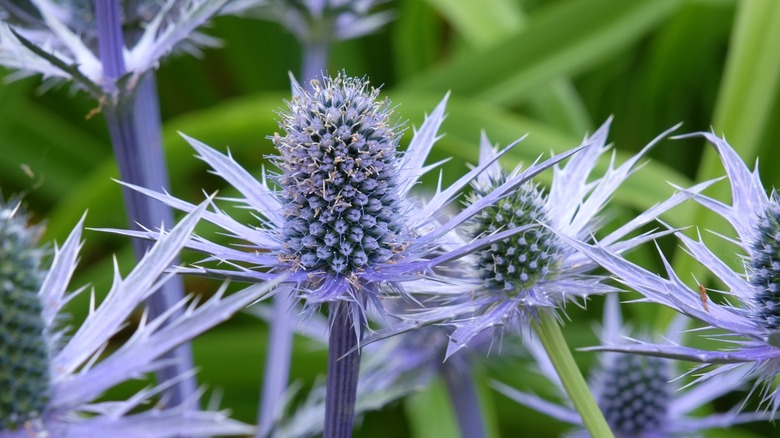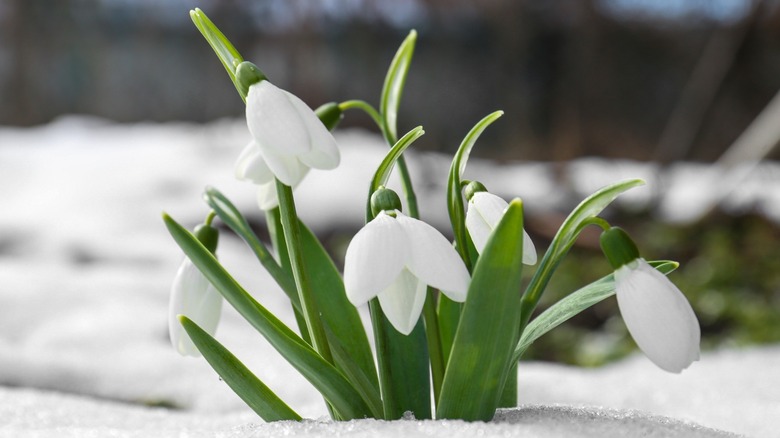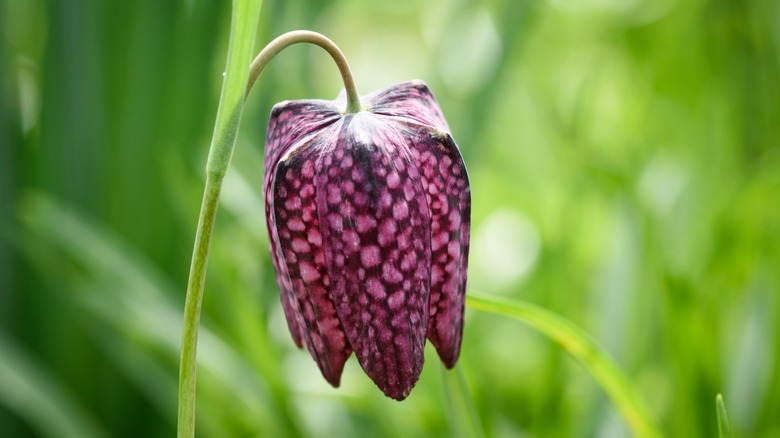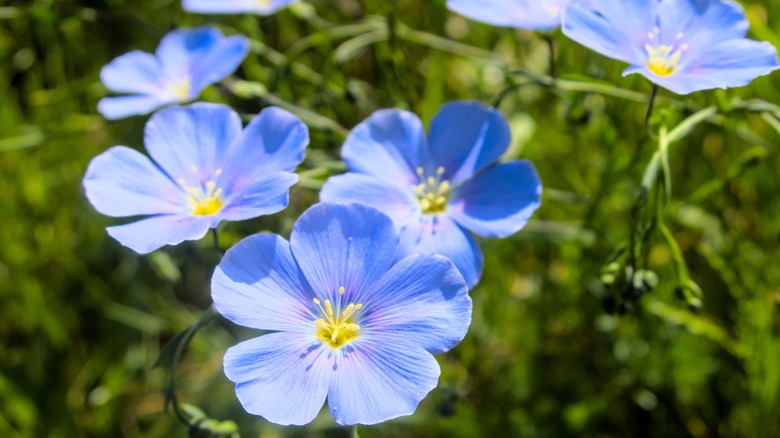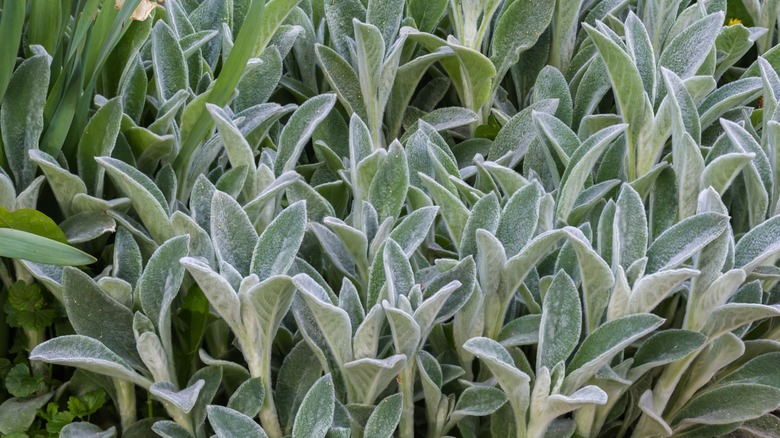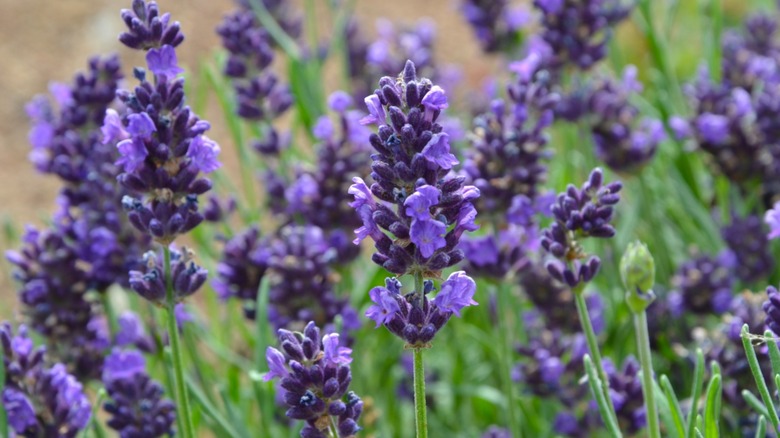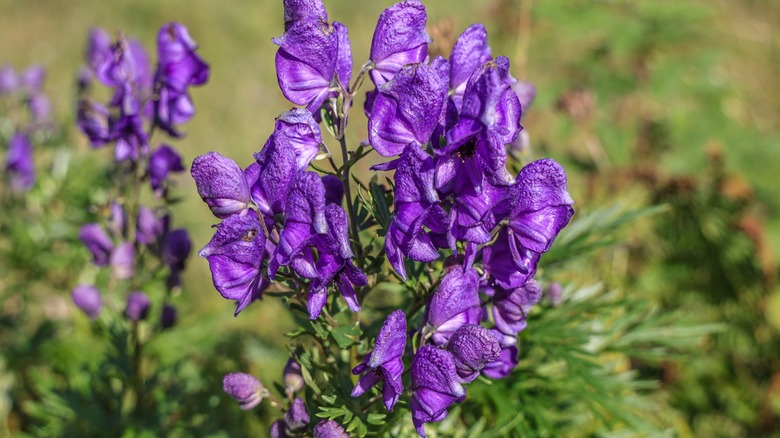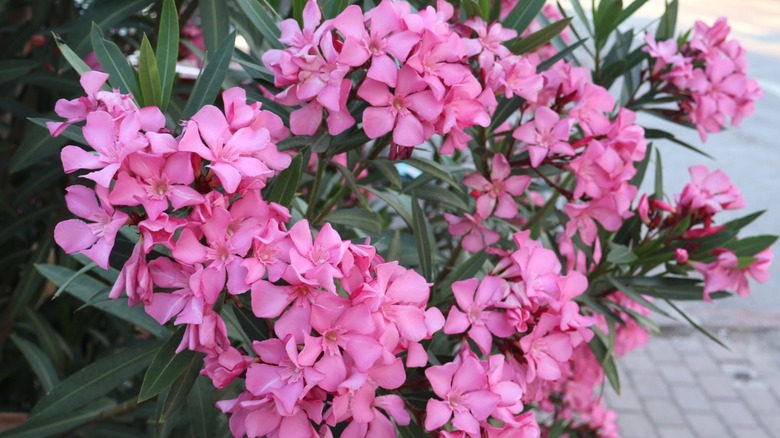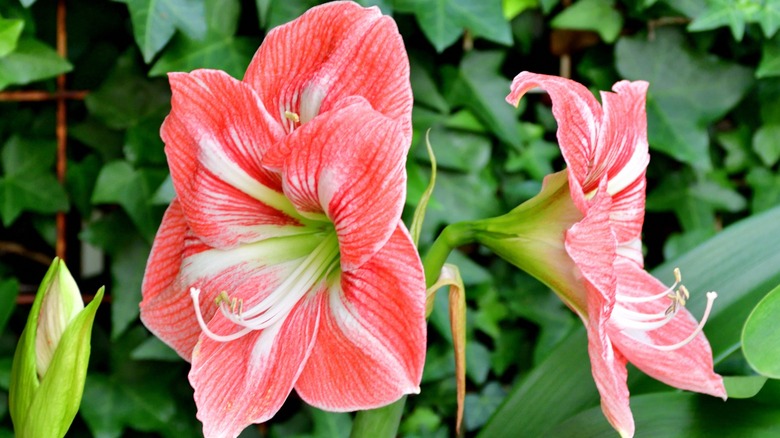Keep Rabbits Out Of Your Garden With 13 Flowers They Can't Stand
You're not the only one who thinks your garden looks delicious. Rabbits do, too. And they'll happily help themselves to your plants and carefully spaced borders. One morning, you might just wake up to find weeks of hard work chewed down to the stems. Now, most experts recommend fencing them out with chicken wire. And to be fair, that works if you've got the time, space, and patience to keep repairing gaps. But as effective as it may be, a chicken wire fence still has its disadvantages. For the most part, it might leave your garden looking tatty over time or injure you and any pets you have around. That's why others recommend repellents like blood meal, fox urine, egg solids, or hot sauce. But let's be honest: you didn't plan a beautiful garden just to make it smell awful.
A better idea is to apply the principles of companion planting which, when you think about it, means choosing plants that make your garden as a whole less vulnerable. In this case, that means adding flowers that do the repelling for you. So, to ensure bunnies don't treat your garden like an all-you-can-eat buffet, we've handpicked some of the most effective rabbit-resistant flowers — from snowdrops to English lavender.
Some plants naturally disgust rabbits with how they smell, taste, or feel. Others are even mildly toxic, and when these little animals nibble on some, they may get sick. Many of these flowers will also turn away other garden pests, attract helpful pollinators, and leave your garden much healthier and good-looking.
Blanket flower
It's called a blanket flower (Gaillardia spp.), not because of its height, but because its striking red and gold blooms look like the patterns you'd find on traditional Indigenous American blankets. But that's just one more reason to love this plant.
It's on our list because its leaves and stems have a coarse, slightly hairy texture that rabbits dislike very much. Plus, it's one of the easiest perennials to grow. It's hardy from USDA Zones 3 through 10, thrives in full sun, and doesn't need much fertilizing.
False indigo
You can count on false indigo (Baptisia australis) to accentuate your borders with its tall, pea-like blooms that are actually bright indigo-blue. But as beautiful and delicate as it looks, rabbits, and even deer, rarely touch it. And that's because the foliage is thick, slightly bitter, and not particularly appetizing, so it generally puts off many browsing animals.
This plant works almost anywhere, from growing Zones 3 to 9. It's also low-maintenance. It may start growing slowly, but once established, its deep taproots help add nitrogen to the soil. But those roots also make it hard to move elsewhere.
Globe thistle
Another stunning blue flower worth adding to your garden is globe thistle (Echinops ritro). For starters, it pairs beautifully with other summer-blooming perennials. But more importantly, the same features that make it visually striking (those spiky, globe-shaped flower heads) also help keep rabbits away.
They're rough and spiny to touch, which isn't exactly appealing to animals that tend to go for smoother foliage. Even the stems and leaves are coarse, making it a solid choice for protecting vulnerable corners of your garden, especially if you're trying to get young or delicate plants established in Zones 3 through 9.
Sea holly
Sea holly (Eryngium agavifolium) is just as striking as globe thistle, but it's hardy across a smaller range of growing zones (6 to 9). With leaves just as spiny and a flower head just as abrasive, it's hard for grazing animals like rabbits to chew on. However, despite its prickly appearance, sea holly is highly attractive to pollinators. Bees and butterflies are drawn to the flowers, which also hold up beautifully in fresh or dried arrangements. If you're harvesting some for your vase, make sure you wear gloves, so the sharp edges don't catch on your skin.
Snowdrops
Snowdrops (Galanthus) might be small, but their bulbs and leaves contain natural alkaloids, which give off a bitter taste most animals learn to stay away from after one bite. Even for you, it's a good idea to wear gloves when handling the bulbs because they can be mildly irritating to the skin.
They thrive best in Zones 3 through 8, especially in spots that get partial shade. Because of their size, they're perfect for tucking beneath deciduous trees like hostas or along shaded borders. Plant in the fall, and they'll begin to naturalize, slowly multiplying without you doing much.
Fritillaria
Fritillaria is another flower genus that offers little temptation to browsing animals. The larger variety, known as crown imperial (F. imperialis), produces a strong, musky scent. Some say it smells like garlic; others say it's close enough to a fox's scent. Either way, it's skunky enough to repulse rabbits, deer, and even rodents, but not too awful that it bothers the human nose. The smaller species, like checkered lily (F. meleagris), may look more delicate, but is just as rabbit-resistant. Hardy across growing Zones 4 to 8, fritillaria bulbs prefer moist, well-drained soil and do best in full sun.
Wormwood
You may already know wormwood (Artemisia absinthium) as absinthe. It's commonly used as a medicine to improve digestion. Like most aromatic herbs, it has a strong, sharp, bitter fragrance that naturally discourages browsing. And one thing we know so far is that rabbits tend to avoid anything that smells this intense, especially when it's paired with a flavor that's just as unappealing. Because of that, you can use wormwood as a border plant to form a protective barrier around the more vulnerable vegetables or ornamentals. Once established in Zones 4 to 9, it's rarely bothered by pests or disease.
Blue flax
Blue flax (Linum perenne) doesn't give off any sharp odor. It just isn't tempting. The wiry stems might look delicate, but they're surprisingly tough, which makes them hard for animals to chew. They're so durable they were once used to make ropes.
Now, the flowers are mostly used to make linen and linseed oil. But they do contain trace amounts of cyanide, so they're pretty toxic if ingested, uncooked. They are, however, pretty easy to grow, and perfect for rock gardens or meadows along Zones 5 to 8. Once it settles in, it'll reseed and return each year.
Lamb's ear
Lamb's ear (Stachys byzantina) is another plant that's just not appealing to grazers because of its texture. It has dense woolly hairs on each leaf so most animals, including rabbits and deer, rarely reach for it. But in gardens from Zones 4 through 8, it does so much more than keep browsing animals away.
For starters, it's actually a great grass alternative for your lawn. Additionally, lamb's ear is a beautiful way to cover any unsightly tree roots you may have sprawling around your garden. And lastly, lamb's ear makes it difficult for weeds to grow around it.
English lavender
You might find the fragrance of English lavender (Lavandula angustifolia) calming, but many animals, including rabbits, tend to respond differently. That's because its fragrance, rich as it is, lingers for long after you've brushed past. That intensity, combined with its bitter leaves, puts off most curious grazers. And unlike many other aromatics, lavender keeps its scent through the heat of summer, making it a reliable defense mechanism. It prefers drier conditions, though, and as a result, performs best in Zones 5 through 8. With adequate care, lavender can thrive for up to a decade in your garden.
Monkshood
As beautiful as monkshood (Aconitum napellus) is, this plant is one of the most toxic perennials you can grow. Every part of it, especially the roots, contains potent alkaloids that make it highly unpalatable to rabbits, deer, and even humans. Its toxicity has long been documented in both folklore and medical literature, and for that reason, you need to plant with caution. Ingesting it doesn't just cause slight nausea — it could actually lead to death. Monkshood is hardy in Zones 3 to 8, and thrives in cool, moist, partly shaded beds where it adds a pretty, yet deadly touch of purple.
Oleander
While oleander (Nerium oleander) is one of the best hedges you can plant in your yard for some privacy, every part of the plant — leaves, stems, blooms, and sap — contains cardiac glycosides that can be fatal if too much of it is ingested. That alone makes it a natural deterrent for rabbits and other animals including cats, dogs, and horses. This plant can't withstand the cold; it performs best in Zones 8 through 11. Most people tend to forget how toxic oleanders are, so be mindful if you have children or pets nearby, and always wear gloves when pruning.
Amaryllis
You might not expect to see amaryllis (Hippeastrum) on this because it's more popular as one of the easiest flowers to gift on holidays. But, you may want to think twice before planting amaryllis in your garden, especially if you have pets. And that's primarily because its bulbs and leaves contain lycorine, a chemical compound that causes nausea if eaten. Most rabbits learn quickly to avoid it. Outdoors, amaryllis grows best in USDA Zones 8 to 11, where it thrives in full sun and well-drained soil. In cooler regions, you can grow them in pots and overwinter indoors.
